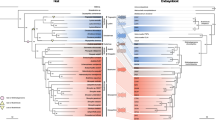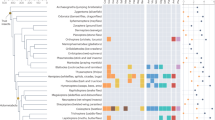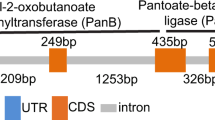Abstract
Symbionts can regulate animal reproduction in multiple ways, but the underlying physiological and biochemical mechanisms remain largely unknown. The presence of multiple lineages of maternally inherited, intracellular symbionts (the primary and secondary symbionts) in terrestrial arthropods is widespread in nature. However, the biological, metabolic, and evolutionary role of co-resident secondary symbionts for hosts is poorly understood. The bacterial symbionts Hamiltonella and Arsenophonus have very high prevalence in two globally important pests, the whiteflies Bemisia tabaci and Trialeurodes vaporariorum, respectively. Both symbionts coexist with the primary symbiont Portiera in the same host cell (bacteriocyte) and are maternally transmitted. We found that elimination of both Hamiltonella and Arsenophonous by antibiotic treatment reduced the percentage of female offspring in whiteflies. Microsatellite genotyping and cytogenetic analysis revealed that symbiont deficiency inhibited fertilization in whiteflies, leading to more haploid males with one maternal allele, which is consistent with distorted sex ratio in whiteflies. Quantification of essential amino acids and B vitamins in whiteflies indicated that symbiont deficiency reduced B vitamin levels, and dietary B vitamin supplementation rescued fitness of whiteflies. This study, for the first time, conclusively demonstrates that these two intracellular symbionts affect sex ratios in their whitefly hosts by regulating fertilization and supplying B vitamins. Our results reveal that both symbionts have the convergent function of regulating reproduction in phylogenetically-distant whitefly species. The 100% frequency, the inability of whiteflies to develop normally without their symbiont, and rescue with B vitamins suggests that both symbionts may be better considered co-primary symbionts.
Similar content being viewed by others
Log in or create a free account to read this content
Gain free access to this article, as well as selected content from this journal and more on nature.com
or
Data availability
All relevant data supporting the findings of this study are included within the article and its Supplementary Information files or available on request.
References
McFall-Ngai M, Hadfield MG, Bosch TCG, Carey HV, Domazet-Lošo T, Douglas AE, et al. Animals in a bacterial world, a new imperative for the life sciences. Proc Natl Acad Sci USA. 2013;110:3229–36.
Moran NA, Bennett GM. The tiniest tiny genomes. Annu Rev Microbiol. 2014;68:195–215.
Douglas AE. Multiorganismal insects: diversity and function of resident microorganisms. Annu Rev Entomol. 2015;60:17–34.
Engelstädter J, Hurst GDD. The ecology and evolution of microbes that manipulate host reproduction. Annu Rev Ecol Evol Syst. 2009;40:127–49.
Ma WJ, Schwander T. Patterns and mechanisms in instances of endosymbiont-induced parthenogenesis. J Evol Biol. 2017;30:868–88.
Bondy EC, Hunter MS. Sex ratios in the haplodiploid herbivores, aleyrodidae and thysanoptera: a review and tools for study. Adv Insect Physiol. 2019;56:251–81.
Hunter MS, Perlman SJ, Kelly SE. A bacterial symbiont in the Bacteroidetes induces cytoplasmic incompatibility in the parasitoid wasp Encarsia pergandiella. Proc Natl Acad Sci USA. 2003;270:2185–90.
Beckmann JF, Ronau JA, Hochstrasser MA. Wolbachia deubiquitylating enzyme induces cytoplasmic incompatibility. Nat Microbiol 2017;2:17007.
Harumoto T, Lemaitre B. Male-killing toxin in a bacterial symbiont of Drosophila. Nature 2018;557:252–5.
Hosokawa T, Koga R, Kikuchi Y, Meng XY, Fukatsu T. Wolbachia as a bacteriocyte-associated nutritional mutualist. Proc Natl Acad Sci USA. 2010;107:769–74.
Michalkova V, Benoit JB, Weiss BL, Attardo GM, Aksoy S. Vitamin B6 generated by obligate symbionts is critical for maintaining proline homeostasis and fecundity in tsetse flies. Appl Environ Microbiol. 2014;80:5844–53.
Moriyama M, Nikoh N, Hosokawa T, Fukatsu T. Riboflavin provisioning underlies Wolbachia’s fitness contribution to its insect host. mBio . 2015;6:e01732–15.
Snyder AK, Rio RVM. ‘Wigglesworthia morsitans’ folate (vitamin B9) biosynthesis contributes to tsetse host fitness. Appl Environ Microbiol. 2015;81:5375–86.
Ju JF, Bing XL, Zhao DS, Guo Y, Xi Z, Hoffmann AA, et al. Wolbachia supplement biotin and riboflavin to enhance reproduction in planthoppers. ISME J. 2019;14:676–87.
Tsuchida T, Koga R, Shibao H, Matsumoto T, Fukatsu T. Diversity and geographic distribution of secondary endosymbiotic bacteria in natural populations of the pea aphid, Acyrthosiphon pisum. Mol Ecol. 2002;11:2123–35.
Baumann P. Biology of bacteriocyte-associated endosymbionts of plant sap-sucking insects. Annu Rev Microbiol. 2005;59:155–89.
Gottlieb Y, Ghanim M, Gueguen G, Kontsedalov S, Vavre F, Fleury F, et al. Inherited intracellular ecosystem: symbiotic bacteria share bacteriocytes in whiteflies. FASEB J. 2008;22:2591–9.
Sloan DB, Moran NA. Genome reduction and co-evolution between the primary and secondary bacterial symbionts of psyllids. Mol Biol Evol. 2012;29:3781–92.
Skaljac M, Zanic K, Ban SG, Kontsedalov S, Ghanim M. Co-infection and localization of secondary symbionts in two whitefly species. BMC Microbiol. 2010;10:142.
McCutcheon JP, Von Dohlen CD. An interdependent metabolic patchwork in the nested symbiosis of mealybugs. Curr Biol. 2011;21:1366–72.
Husnik F, Nikoh N, Koga R, Ross L, Duncan RP, Fujie M, et al. Horizontal gene transfer from diverse bacteria to an insect genome enables a tripartite nested mealybug symbiosis. Cell. 2013;153:1567–78.
Koga R, Meng XY, Tsuchida T, Fukatsu T. Cellular mechanism for selective vertical transmission of an obligate insect symbiont at the bacteriocyte-embryo interface. Proc Natl Acad Sci USA. 2012;109:E1230–E1237.
Fukatsu T, Nikoh N. Two intracellular symbiotic bacteria from the mulberry psyllid Anomoneura mori (Insecta, Homoptera). Appl Environ Microbiol. 1998;64:3599–606.
Degnan PH, Yu Y, Sisneros N, Wing RA, Moran NA. Hamiltonella defensa, genome evolution of protective bacterial endosymbiont from pathogenic ancestors. Proc Natl Acad Sci USA. 2009;106:9063–8.
Rao Q, Wang S, Su YL, Bing XL, Liu SS, Wang XW. Draft genome sequence of ‘Candidatus Hamiltonella defensa’ an endosymbiont of the whitefly Bemisia tabaci. J Bacteriol. 2012;194:3558.
Xue J, Zhou X, Zhang CX, Yu LL, Fan HW, Wang Z, et al. Genomes of the rice pest brown planthopper and its endosymbionts reveal complex complementary contributions for host adaptation. Genome Biol. 2014;15:521.
Santos-Garcia D, Juravel K, Freilich S, Zchori-Fein E, Latorre A, Moya A, et al. To B or not to B: comparative genomics suggests Arsenophonus as a source of B vitamins in whiteflies. Front Microbiol. 2018;9:2254–70.
Ouvrard D, Martin JH. The whiteflies: taxonomic checklist of the world’s whiteflies (Insecta: Hemiptera: Aleyrodidae). 2019. http://www.hemiptera-databases.org/whiteflies/.
Yang P. The greenhouse whiteflies and plant quarantine. Chin Bull Entomol. 1981;18:69–71.
Liu SS, De Barro PJ, Xu J, Luan JB, Zang LS, Ruan YM, et al. Asymmetric mating interactions drive widespread invasion and displacement in a whitefly. Science . 2007;318:1769–72.
Zchori-Fein E, Lahav T, Freilich S. Variations in the identity and complexity of endosymbiont combinations in whitefly hosts. Front Microbiol. 2014;5:310.
Luan JB, Shan HW, Isermann P, Huang JH. Cellular and molecular remodelling of a host cell for vertical transmission of bacterial symbionts. Proc R Soc B. 2016;283:20160580.
Luan JB, Sun XP, Fei ZJ, Douglas AE. Maternal inheritance of a single somatic animal cell displayed by the bacteriocyte in the whitefly Bemisia tabaci. Curr Biol. 2018;28:459–65.
Shan HW, Luan JB, Liu YQ, Douglas AE, Liu SS. The inherited bacterial symbiont Hamiltonella influences the sex ratio of an insect host. Proc R Soc B. 2019;286:20191677.
Rao Q, Rollat-Farnier PA, Zhu DT, Santos-Garcia D, Silva FJ, Moya A, et al. Genome reduction and potential metabolic complementation of the dual endosymbionts in the whitefly Bemisia tabaci. BMC Genom. 2015;16:226.
Scott IAW, Workman PJ, Drayton GM, Burnip GM. First record of Bemisia tabaci biotype Q in New Zealand. N Z Plant Prot. 2007;60:264–70.
Qin L, Pan LL, Liu SS. Further insight into reproductive incompatibility between putative cryptic species of the Bemisia tabaci whitefly complex. Insect Sci. 2016;23:215–24.
Xu XR, Li NN, Bao XY, Douglas AE, Luan JB. Patterns of host cell inheritance in the bacterial symbiosis of whiteflies. Insect Sci. 2019; https://doi.org/10.1111/1744-7917.12708.
Schmittgen TD, Livak KJ. Analyzing real-time PCR data by the comparative CT method. Nat Protoc. 2008;3:1101–8.
Gottlieb Y, Ghanim M, Chiel E, Gerling D, Portnoy V, Steinberg S, et al. Identification and localization of a Rickettsia sp. in Bemisia tabaci (Homoptera: Aleyrodidae). Appl Environ Microbiol. 2006;72:3646–52.
Hadjistylli M, Schwartz SA, Brown JK, Roderick GK. Isolation and characterization of nine microsatellite loci from Bemisia tabaci (Hemiptera: Aleyrodidae) biotype B. J Insect Sci. 2014;14:148.
Bondy EC, Hunter MS. Determining the egg fertilization rate of Bemisia tabaci using a cytogenetic technique. J Vis Exp. 2019;https://doi.org/10.3791/59213.
Ankrah NYD, Luan JB, Douglasa AE. Cooperative metabolism in a three-partner insect-bacterial symbiosis revealed by metabolic modeling. J Bacteriol 2017;199:e00872–16.
Ren FR, Bai B, Hong JS, Huang YZ, Luan JB. A microbiological assay for biotin determination in insects. Insect Sci. 2020; https://doi.org/10.1111/1744-7917.12827.
Salem H, Bauer E, Strauss AS, Vogel H, Marz M, Kaltenpoth M. Vitamin supplementation by gut symbionts ensures metabolic homeostasis in an insect host. Proc R Soc B. 2014;281:1838.
Duron O, Morel O, Noël V, Buysse M, Binetruy F, Lancelot R, et al. Tick-bacteria mutualism depends on B vitamin synthesis pathways. Curr Biol. 2018;28:1896–902.
Pant NC, Fraenkel G. The function of the symbiotic yeasts of two insect species, Lasioderma serricorne F. and Stegobium (Sitodrepa) paniceum L. Science. 1950;112:498–500.
Byrne DN, Bellows TS Jr. Whitefly biology. Annu Rev Entomol. 1991;36:431–57.
Giorgini M, Monti MM, Caprio E, Stouthamer R, Hunter MS. Feminization and the collapse of haplodiploidy in an asexual parasitoid wasp harboring the bacterial symbiont Cardinium. Heredity. 2009;102:365–71.
Ma WJ, Pannebakker BA, van de Zande L, Schwander T, Wertheim B, Beukeboom LW. Diploid males support a two-step mechanism of endosymbiont-induced thelytoky in a parasitoid wasp. BMC Evol Biol. 2015;15:84.
Sloan DB, Moran NA. The evolution of genomic instability in the obligate endosymbionts of whiteflies. Genome Biol Evol. 2013;5:783–93.
Chen W, Hasegawa DK, Kaur N, Kliot A, Pinheiro PV, Luan JB, et al. The draft genome of whitefly Bemisia tabaci MEAM1, a global crop pest, provides novel insights into virus transmission, host adaptation, and insecticide resistance. BMC Biol. 2016;14:110.
Luan JB, Chen W, Hasegawa DK, Simmons A, Wintermantel WM, Ling KS, et al. Metabolic coevolution in the bacterial symbiosis of whiteflies and related plant sap-feeding insects. Genome Biol Evol. 2015;7:2635–47.
Russell JA, Latorre A, Sabater-Muñoz B, Moya A, Moran NA. Side-stepping secondary symbionts: widespread horizontal transfer across and beyond the Aphidoidea. Mol Ecol. 2003;12:1061–75.
Manzano-Marı́n A, Coeur d’acier A, Clamens AL, Orvain C, Cruaud C, Barbe V, et al. Serial horizontal transfer of vitamin-biosynthetic genes enables the establishment of new nutritional symbionts in aphids’ di-symbiotic systems. ISME J. 2020;14:259–73.
Ayoubi A, Talebi AA, Fathipour Y, Mehrabadi M. Coinfection of the secondary symbionts, Hamiltonella defensa and Arsenophonus sp. contribute to the performance of the major aphid pest, Aphis gossypii (Hemiptera: Aphididae). Insect Sci. 2020;27:86–98.
Thao MLL, Baumann P. Evidence for multiple acquisition of Arsenophonus by whitefly species (Sternorrhyncha: Aleyrodidae). Curr Microbiol. 2004;48:140–4.
Nováková E, Hypša V, Moran NA. Arsenophonus, an emerging clade of intracellular symbionts with a broad host distribution. BMC Microbiol. 2009;9:143.
Nováková E, Husník F, Šochová E, Hypša V. Arsenophonus and Sodalis symbionts in louse flies: an analogy to the Wigglesworthia and Sodalis system in tsetse flies. Appl Environ Microbiol. 2015;81:6189–99.
Nikoh N, Hosokawa T, Moriyama M, Oshima K, Hattori M, Fukatsu T. Evolutionary origin of insect-Wolbachia nutritional mutualism. Proc Natl Acad Sci USA. 2014;111:10257–62.
Wu D, Daugherty SC, Van Aken SE, Pai GH, Watkins KL, Khouri H, et al. Metabolic complementarity and genomics of the dual bacterial symbiosis of sharpshooters. PLoS Biol. 2006;4:e188.
McCutcheon JP, Moran NA. Parallel genomic evolution and metabolic interdependence in an ancient symbiosis. Proc Natl Acad Sci USA. 2007;104:19392–7.
McCutcheon JP, McDonald BR, Moran NA. Convergent evolution of metabolic roles in bacterial co-symbionts of insects. Proc Natl Acad Sci USA. 2009;106:15394–9.
Matsuura Y, Moriyama M, Łukasik P, Vanderpool D, Tanahashi M, Meng XY, et al. Recurrent symbiont recruitment from fungal parasites in cicadas. Proc Natl Acad Sci USA. 2018;115:E5970–E5979.
Kapantaidaki DE, Ovcarenko I, Fytrou N, Knott KE, Bourtzis K, Tsagkarakou A. Low levels of mitochondrial DNA and symbiont diversity in the worldwide agricultural pest, the greenhouse whitefly Trialeurodes vaporariorum (Hemiptera: Aleyrodidae). J Hered. 2014;106:80–92.
Douglas AE. The B vitamin nutrition of insects: the contributions of diet, microbiome and horizontally acquired genes. Curr Opin Insect Sci. 2017;23:65–69.
Smykal V, Raikhel AS. Nutritional control of insect reproduction. Curr Opin Insect Sci. 2015;11:31–38.
Wheeler D. The role of nourishment in oogenesis. Ann Rev Entomol. 1996;41:407–31.
Himler AG, Adachi-Hagimori T, Bergen JE, Kozuch A, Kelly SE, Tabashnik BE, et al. Rapid spread of a bacterial symbiont in an invasive whitefly is driven by fitness benefits and female bias. Science. 2011;332:254–6.
Acknowledgements
This work was supported by the National Natural Science Foundation of China (Project 31871967), High-tech R&D Program of Liaoning (Project 2019JH2/10200012) and High-Level Talent Support Foundation from Liaoning, Shenyang and Shenyang Agricultural University (Project XLYC1902104, RC180025 and 880418001). The authors thank Dr. Adam Dobson from the University of Glasgow for constructive comments, Professor Martha S. Hunter from the University of Arizona for very helpful advice on this work, Dr. Zhang Chang-Rong, Dr. Zang Lian-Sheng, Dr. Hu Jian, Dr. Wang Yu-Bo and Dr. Li Yu-Ting for collecting whitefly populations, Professor Liu Shu-Sheng from Zhejiang University for providing the whitefly B. tabaci MEAM1 culture, Dr. Shan Hong-Wei, Zhao Jing and He Wen-Ze for help with this study, Zang Jian for help with amino acid analysis, Dr. Feng Ying for assistance with using confocal microscopy, Wang Tian-Yu and Lu Yue for help with ecological experiments and thank Dr. Santos-Garcia from the Hebrew University of Jerusalem for kindly providing the genome data of Arsenophonus in T. vaporariorum.
Author information
Authors and Affiliations
Contributions
J.B.L. conceived the study and wrote the first draft of the manuscript. Y.B.W. conducted ecology experiments. N.N.L. conducted genotyping experiments. Y.L.Y. and X.S. carried out cytogenetic experiments. F.R.R., Y.L.Y., Y.B.W., X.S., B.B., and X.Y.B. performed nutritional physiology experiments. X.S. and X.R.X. carried out FISH experiments. L.L.W. contributed to writing the manuscript. All authors edited and approved the paper.
Corresponding author
Ethics declarations
Conflict of interest
The authors declare that they have no conflict of interest.
Additional information
Publisher’s note Springer Nature remains neutral with regard to jurisdictional claims in published maps and institutional affiliations.
Rights and permissions
About this article
Cite this article
Wang, YB., Ren, FR., Yao, YL. et al. Intracellular symbionts drive sex ratio in the whitefly by facilitating fertilization and provisioning of B vitamins. ISME J 14, 2923–2935 (2020). https://doi.org/10.1038/s41396-020-0717-0
Received:
Revised:
Accepted:
Published:
Issue date:
DOI: https://doi.org/10.1038/s41396-020-0717-0
This article is cited by
-
Pantothenate regulates feeding and reproduction in the malaria vector Anopheles stephensi, with patterns dependent on supplementation scheme and parental nutrition
Parasites & Vectors (2025)
-
The phenylalanine synthesized by whitefly–Portiera symbiosis enhances host survival under fungi infection
Journal of Pest Science (2025)
-
PacBio Hi-Fi genome assembly of Sipha maydis, a model for the study of multipartite mutualism in insects
Scientific Data (2024)
-
The plant-sucking insect selects assembly of the gut microbiota from environment to enhance host reproduction
npj Biofilms and Microbiomes (2024)
-
Detection of Arsenophonus in Glycaspis brimblecombei (Hemiptera: Aphalaridae) populations in Brazil
Brazilian Journal of Microbiology (2024)



